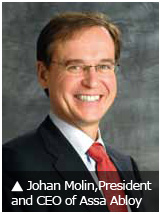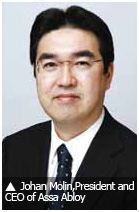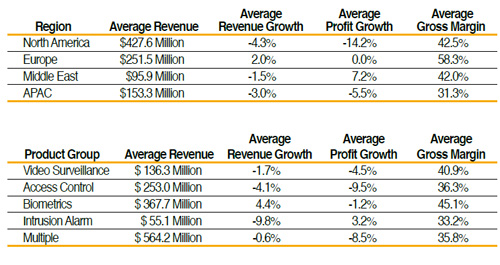Mergers and acquisitions continued, even in the face of tighter lending policies. Flir bought thermal imaging provider OmniTech in June 2009. It also purchased Directed Perception in December 2009, enhancing its PTZ camera line.
Consolidation
Mergers and acquisitions continued, even in the face of tighter lending policies. Flir bought thermal imaging provider OmniTech in June 2009. It also purchased Directed Perception in December 2009, enhancing its PTZ camera line.
“Throughout the years, Flir has grown our business both organically and through acquisitions,” Klink said. “We expect to continue in both growth models in the future.”
There cession temporarily dampened Assa Abloy's consolidation plans, which ended 2009 with eight new manufacturers in its portfolio. “As a result of the financial crisis and the uncertain economic situation in early 2009, acquisition activities were stopped and only running projects were completed,” Molin said. “As the year progressed with a stabilizing sales trend on a number of important markets and a strengthened balance sheet, acquisition activities were resumed.”
In access, ADT bought RFID provider Vue Technology, which made up the bulk of $50 million spent on acquisitions. Vue's RFID solutions will become part of the Sensormatic retail loss prevention portfolio, ADT said in a prepared statement.
L-1's playbook relied on strategic acquisitions, giving it a comprehensive biometric lineup. However, its consolidation activity stalled in 2009 as it went on the auction block for a buyer. Just one acquisition took place this April, when L-1 purchased iris recognition provider Retica Systems.
“When I became Chairman in 2005, we targeted 2010 as the year in which we would reflect upon the successful company we built and determine what is required to take it to the next level,” said Robert LaPenta, Chairman of the Board, President and CEO of L-1 Identity Solutions, in a prepared statement.
As fate would have it, Safran made an offer for L-1's identity solutions this year, while BAE Systems bid for its government services.
Growing Pains
High sales are a plus, but come at a cost. Growth requires additional overhead costs for salaries, office space and utilities. Corporate expansion needs careful oversight to be sustainable, but growing pains are enviable.
Hikvision went from about 2,000 employees in 2009 to more than 3,000 staff today, reflecting its robust growth. “Expansion benefits our customers,” Yang said.
Other Top 10 manufacturers also employed more than 2,000 staffers. L-1 had 2,339 full-time employees in 2009, while Flir had 2,079 employees worldwide. Some providers had no choice but to release workers due to tough market conditions, including Assa Abloy. Increased automation in its production line resulted in 4,631 employees being let go.
In some instances, it is hard to recruit the right talent. “It is a challenge on the human resources front to find suitable expertise in the industry to maintain strong R&D, yet at the same time be able to commercialize the technology,” Lee said.
 Channel Partners
Channel Partners
People were a theme for the Security 50 participants. Along with recruiting for the best and brightest, manufacturers sought reputable distributors and integrators in key markets.
Hikvision has ramped up its channel expansion in the past two years, including setting up joint ventures in Russia and India. “For most manufacturers, they treat local partners as distributors,” Yang said. “We expend more effort to further the partnership. If they cannot provide service, you will lose business.”
Part of this effort includes product education. “If distributors don't see your offering as valuable, they can replace you with other manufacturers or not promote your products,” Yang said. “We need to maintain our channel relationships and preempt issues before distributors switch out our products.”
Additional competition makes it harder for manufacturers to explain their benefits to customers. “The group decided to increase the number of marketing activities to promote our products and solutions, gain new customers, and maintain relationships with existing customers and increased RCG's market share across different sectors,” Lee said.
OEM Partne rs Finding talent extends to the supply chain, with the recession putting several OEM suppliers out of business. Replacing these suppliers is no easy task, as they must meet specific criteria.
 Bosch's partners and suppliers must follow high demands on quality, capability and flexibility over a long period of time, said Clemens Krebs, Director of Corporate Communications, Bosch Security Systems.
Bosch's partners and suppliers must follow high demands on quality, capability and flexibility over a long period of time, said Clemens Krebs, Director of Corporate Communications, Bosch Security Systems.
Flexibility is essential for both OEM suppliers and product makers. “Security systems continue to be a sector with good prospects for growth for the coming years,” Krebs said.
“We'll continue our successful strategy of the past years by strengthening our innovation power by high efforts in R&D and in cooperation with our strategic partners,” Krebs said. “With this strategy, we have been able to strengthen our position in the world market and have gained market share in the difficult year of 2009.”
De cade Ahe ad Security is coming off a decade of nonstop growth, with profit expectations being scaled back. As the financial crisis brings a more reflective mood, it raises questions about the future.
Will product makers increasingly transition to total solution providers? Will standards blur the boundaries between product categories? How will IT affect physical security?
The recession was a surprise to everyone. “For us, it's hard to know what's next,” Yang said. “One of our advantages is our flexibility to provide what the customers are looking for, which gives us an edge in the market.”
Regardless of what's ahead, some manufacturers will follow best business practices. “We think that there are good opportunities, especially with implementation of new and suitable technologies,” Lee said.
“We will expand the business through various strategies, including acquisition, organic expansion, new product and solution launches, actively securing government contracts, and continuing expansion to lucrative geographies,” Lee added.
One thing is certa in: More cost-effective offerings will be available as security moves forward. Manufacturers can no longer sell on brand recognition alone, as users become more educated and securitysavv
This makes the industry more transparent, but also places the burden on product manufacturers to justify the cost of their solutions. Value will be the unmistakable trend of the future.
Lessons Learned
The Security 50 participants learned different lessons from the recession. Some found that flexibility helped them survive. Others discovered new markets. Almost all maintained a rapport with their customers, delivering solutions that matched their needs.
RCG' s openness to change resulted in flexible strategy adjustments and prudent cost control while continuing expansion, Lee said. In the long term, these practices set a foundation for the company to be prepared for when markets rebound.

For Flir, diversifying its business across several product types and end-user markets enabled the company to “withstand weaknesses in one area by strengths in others,” Klink said.
Hikvision felt the recession was less of a lesson and more a test of its mettle. “We maintained our core competence and offered value. Regardless of what happens, we cannot lose value,” Yang said. “A corporation should have a clear direction and position that is not swayed by external conditions.”
For Bosch, the recession's trials proved it was on the right track. “Overcoming the economic crisis with sustainable corporate growth, we see us accepted in our previous strategy: spending enough money in R&D, faithful partnerships with competent local partners and powerful support to our customers,” Krebs said.
Globalization has reshaped the worldwide economy for unparalleled growth. However, it introduces risks, including are cession slamming the whole world simultaneously. Security players must be aware of the risks in a global marketplace, while embracing opportunities for strong connections.
Find More 2010 Security 50 Articles :
● Asia Weathers the Storm
 ● Growing Profits in Lean Times Part Ⅱ
● Growing Profits in Lean Times Part Ⅱ
● Growing Profits in Lean Times PartⅠ
● Bucking the Downward Trend: Top 10 Revenue Growers of 2009
● Security 50's Top Performers Rise Above the Fray Part Ⅰ